I've gotten to a point in my collecting that I've decided I need a few scabbards before I consider adding more swords. I'm always on the look-out for some great ideas, and love seeing the custom designs people have gotten.
I recently had one made by DBK Custom Swords for my Albion Landgraf, and I received it a few weeks ago. I'm very pleased with how it turned out. The chape and the "rain flap" have styling modeled after the guard and pommel respectively. It has an integrated double-suspension. The draw is perfectly smooth and effortless, and yet the blade is retained even if you turn the scabbard up-side down. The fit is perfect. And the scabbard + suspension visually work well together, making a nice overall aesthetic package.
[ Linked Image ]
[ Linked Image ]
[ Linked Image ]
[ Linked Image ]
I'd love to see some more scabbards! Do you have any to share?
Last edited by Ed Toton on Mon 05 Apr, 2010 10:29 am; edited 1 time in total
About two years ago, I also had one made by Christian Fletcher for an Albion Baron. I've shown both this one and the Albion Landgraf above in other threads before, but I think this thread is a great way to show off scabbards particularly.
[ Linked Image ] [ Linked Image ] [ Linked Image ] [ Linked Image ]
The color is a little subdued in these photos. The grip and scabbard are both dark blue in color, though the grip is darker. Suspension is black.
[ Linked Image ] [ Linked Image ] [ Linked Image ] [ Linked Image ]
The color is a little subdued in these photos. The grip and scabbard are both dark blue in color, though the grip is darker. Suspension is black.
Ed: Great idea for a thread. Sorry for taking so long to get back to it.
I think many of us find it easy to caught up in the swords and ignore scabbards, despite the oft-quoted reminders that scabbards often cost as much as a sword (both 'then', as now), and that they fulfilled many different roles: as a carry method, as protection for both blade, wearer, and mount; as a form of display in their own right; and even as a way of maintaining the peace in different social situations (in the sense that walking around with an unsheathed weapon could get you into trouble).
Anway, I'd like to post two scabbards here. These are the first two I had commissioned, earlier this year. In many ways, they were 'test pieces' for both scabbard makers: for me to get a sense of their quality, finish, attention to detail, and customer service, as well as for me to see what's involved in making such a commission before getting scabbards made for some higher-end pieces.
The first is by Brian Kunz at DBK Custom Swords and Scabbards. Actually, it's by Brian's apprentice, as one of his 'Apprentice Line' offerings. This was when his apprentice was relatively new on the job (I think), and I was happy to pay a little less, give the apprentice some work, and also get it back in a very short turnaround (a couple of months, versus Brian's usual year-long queue for the scabbards he makes personally).
The brief was for a no-frills design, to match the no-frills ATrim XVIII Arming Sword (probably an early 1513): this sword has a plain, exposed wood grip, and both the colouring and 'attitude' of the scabbard was to reflect this.
As an ATrim, the sword and scabbard was never going to see duty in a living history context, so it didn't need to be incredibly historically accurate. However, I have a personal ethic that all arms and armour should be thought of as being heirlooms, so the commission was for something rugged, solid, and long-lasting.
I'm also about to take up horseriding again, and wanted a rig that would allow me to experiment with draws on horseback, to get a 'hands on' understanding of what is required from sword, scabbard, belt/carry system, and rider, in this context: an added aspect of 'direct research' beyond physical inspection of pieces and training in their use.
I was attracted to Brian's work not only for their aesthetics and historical accuracy, but also due to ShooterMike's fantastic video showing how Brian's snug fits mean the sword and scabbard can be inverted. (If you haven't seen this, I recommend it!) Now, while I was a little disappointed that my sword falls straight out of the scabbard Brian sent, I can live with this: it's an early offering from his apprentice, and the scabbard went through a lot of temperature and humidity changes to get all the way from him to me. (And we're talking tolerances of a milimetre, or perhaps fractions of, which is important context to keep in mind!)
Aside from that and one or two other minor 'quirks', the scabbard is exactly what I asked for: simple, rugged, understated, and a great complement to the colour and lines of the ATrim. The level of craftsmanship is very high, and everything is tight and clean: a real credit to both Brian and his apprentice. Getting a belt carry right is just as important as the scabbard, to me, and this one is solid and comfortable.
Brian also went beyond the call of duty: when the chape he was hoping to get for the piece wasn't available, he took one off one of his personal scabbards to add to this one - in part, to get the commission back in the stated timeframe, and in part because he simply thought it would look better on my scabbard! What a guy ... (And I love the way it gives this scabbard a really solid 'base': an interesting 'no-nonsense' juxtaposition to some of the more delicate chapes we're used to seeing.)
Anyway: pics. Nothing fancy, but that's why I wanted to share them: Brian's detailed tooling is amazing, but he can do crisp, clean, simple work too. And, if you want something quicker than Brian's 'Premier Line', then the Apprentice Line is a great way to go - high-end quality at a more affordable price.
 Attachment: 194.04 KB
Attachment: 194.04 KB
![ATrimMTA800[1]---complete-scabbard.gif](files/atrimmta800_1_---complete-scabbard_830.gif)
 Attachment: 198.15 KB
Attachment: 198.15 KB
![ATrimMTB800[1]---complete-scabbard.gif](files/atrimmtb800_1_---complete-scabbard_135.gif)
 Attachment: 191.34 KB
Attachment: 191.34 KB
![ATrimMTC800[1]---complete-scabbard.gif](files/atrimmtc800_1_---complete-scabbard_256.gif)
 Attachment: 198.8 KB
Attachment: 198.8 KB
![ATrimMTD800[1]---complete-scabbard.gif](files/atrimmtd800_1_---complete-scabbard_649.gif)
I think many of us find it easy to caught up in the swords and ignore scabbards, despite the oft-quoted reminders that scabbards often cost as much as a sword (both 'then', as now), and that they fulfilled many different roles: as a carry method, as protection for both blade, wearer, and mount; as a form of display in their own right; and even as a way of maintaining the peace in different social situations (in the sense that walking around with an unsheathed weapon could get you into trouble).
Anway, I'd like to post two scabbards here. These are the first two I had commissioned, earlier this year. In many ways, they were 'test pieces' for both scabbard makers: for me to get a sense of their quality, finish, attention to detail, and customer service, as well as for me to see what's involved in making such a commission before getting scabbards made for some higher-end pieces.
The first is by Brian Kunz at DBK Custom Swords and Scabbards. Actually, it's by Brian's apprentice, as one of his 'Apprentice Line' offerings. This was when his apprentice was relatively new on the job (I think), and I was happy to pay a little less, give the apprentice some work, and also get it back in a very short turnaround (a couple of months, versus Brian's usual year-long queue for the scabbards he makes personally).
The brief was for a no-frills design, to match the no-frills ATrim XVIII Arming Sword (probably an early 1513): this sword has a plain, exposed wood grip, and both the colouring and 'attitude' of the scabbard was to reflect this.
As an ATrim, the sword and scabbard was never going to see duty in a living history context, so it didn't need to be incredibly historically accurate. However, I have a personal ethic that all arms and armour should be thought of as being heirlooms, so the commission was for something rugged, solid, and long-lasting.
I'm also about to take up horseriding again, and wanted a rig that would allow me to experiment with draws on horseback, to get a 'hands on' understanding of what is required from sword, scabbard, belt/carry system, and rider, in this context: an added aspect of 'direct research' beyond physical inspection of pieces and training in their use.
I was attracted to Brian's work not only for their aesthetics and historical accuracy, but also due to ShooterMike's fantastic video showing how Brian's snug fits mean the sword and scabbard can be inverted. (If you haven't seen this, I recommend it!) Now, while I was a little disappointed that my sword falls straight out of the scabbard Brian sent, I can live with this: it's an early offering from his apprentice, and the scabbard went through a lot of temperature and humidity changes to get all the way from him to me. (And we're talking tolerances of a milimetre, or perhaps fractions of, which is important context to keep in mind!)
Aside from that and one or two other minor 'quirks', the scabbard is exactly what I asked for: simple, rugged, understated, and a great complement to the colour and lines of the ATrim. The level of craftsmanship is very high, and everything is tight and clean: a real credit to both Brian and his apprentice. Getting a belt carry right is just as important as the scabbard, to me, and this one is solid and comfortable.
Brian also went beyond the call of duty: when the chape he was hoping to get for the piece wasn't available, he took one off one of his personal scabbards to add to this one - in part, to get the commission back in the stated timeframe, and in part because he simply thought it would look better on my scabbard! What a guy ... (And I love the way it gives this scabbard a really solid 'base': an interesting 'no-nonsense' juxtaposition to some of the more delicate chapes we're used to seeing.)
Anyway: pics. Nothing fancy, but that's why I wanted to share them: Brian's detailed tooling is amazing, but he can do crisp, clean, simple work too. And, if you want something quicker than Brian's 'Premier Line', then the Apprentice Line is a great way to go - high-end quality at a more affordable price.
![ATrimMTA800[1]---complete-scabbard.gif](files/atrimmta800_1_---complete-scabbard_830.gif)
![ATrimMTB800[1]---complete-scabbard.gif](files/atrimmtb800_1_---complete-scabbard_135.gif)
![ATrimMTC800[1]---complete-scabbard.gif](files/atrimmtc800_1_---complete-scabbard_256.gif)
![ATrimMTD800[1]---complete-scabbard.gif](files/atrimmtd800_1_---complete-scabbard_649.gif)
Any ideas for us "basket hilters" ( Scots Highland & Lowland/Brit ????
Jack
Jack
| Jack W. Englund wrote: |
| Any ideas for us "basket hilters" |
Scabbards for British basket-hilts are well documented (certainly more so than for earlier periods) and are published in most books dealing with the subject of the swords.
| Nathan Robinson wrote: | ||
Scabbards for British basket-hilts are well documented (certainly more so than for earlier periods) and are published in most books dealing with the subject of the swords. |
Any good sources for current makers ??
Jack
Second up is a scabbard and belt from Russ Ellis at Tritonworks Custom Scabbards.
While also an ATrim, so not needing to be overly historically-accurate, the brief this time was for something a little more 'fancy', and close to historically accurate, to give me an idea of what this kind of commissioning process would be like. So this one was done under Russ' 'Trident line', with me able to choose the exact fittings to use, and with Russ devoting a lot of time and enthusiasm to fleshing out the concept. Again, this was something of a 'test run' to see what it would be like working with Russ. (Note that in each of these 'tests', neither Brian or Russ knew this: I was just commissioning a scabbard like anyone else - but my intention on each was to see what the process and result would be like, and whether I would send them more work in the future. I'm happy to report that I have sent both of them more work, and will again in the future.)
The result, dubbed 'Der Schwarzwaldwolf', or 'wolf of the Black Forest', was to be something that would not be out of place for a southern-German soldier in the mid to late 1470s. The idea was to get a mix of simplicity, even austerity, in the scabbard itself, as suggested by period art of what is now Switzerland, south Germany, and Austria, but with thematic personalization on the belt.
This theme was to combine the elements of both the wolf and the Black Forest. The wolf is represented in the belt plaques, as well as the tooth or fang-like shape of the chape, as well as the sleek lines of the scabbard overall. While we're used to seeing plaques in abundance on earlier 'knightly' belts, they apparently were still used in later periods as well, as a decorative feature. The artistic style used on this plaque might be suggestive of an earlier time; I was happy to think of them as having been handed down in a family and re-used to maintain a link to one's ancestors (my earliest-known ancestor was a German mercenary soldier, and I like the idea of finding ways to maintain links to one's direct forebears through one's bearing of arms in this way). The pointedness of the wolf's tooth is both suggestive of the sword point that resides behind it, and the oxblood of the grip is suggestive of the effect of that sharpness if the sword is removed from its sheath.
The Black Forest is reflected in the acorn detail on the strapend (oaks being a dominant species in the Black Forest), and the stylised branches on the buckle. The 'branch'-like iconography was carried over to the 'rain guard' / chappe - but this time, oriented vertically, they're now suggestive of trees. So, we go from the acorn, to the branches, to the trees themselves, to give a sense of cohesion across the package. I'll give close-up photos of each of these elements below, so you can get an idea of how this all 'hangs together' stylistically, as well as get a sense of the kind of detail that's available with higher-end mounts.
The 'rain guard' / chappe was the first one that Russ had ever made, and it was an interesting learning curve for both of us! Russ charged a very reasonable (I kept telling him it was too cheap) amount for the chappe, as my sword would be something of a 'guinea pig', and he didn't want to make any promises as to the outcome. He also saw it as a great challenge and way to learn about how to make something new - as well as a way to find out if this is something he'd like to add to his offerings ... I think he now is - at least, he's agreed to make another one for me - so, if you're wanting a chappe, ask him nicely and see what happens!
Russ and I were both interested in the recent research and experimentation here on myArmoury: Roland Warzecha and Hammaborg's experimentation with chappes in a functional WMA context, and custom projects documented here by Sean Flynt, Mathieu Harlaut, and Max W. Since then, we've also had Al Muckart's beautiful example in this post, for those who missed it.
Russ also referred to Sheaths, scabbards and grip coverings: Use of leather for portable personal objects in 14th-16th century Turku (Archaeologia Medii Finlandiae), by Janne Harjula (Skas, 2010) - details in this thread - which was being reprinted as we worked on the design, but Russ had sourced an older (and expensive!) copy to use, as it's one of the few historical resources we have for documentation of chappes.
Russ added a riser just below where the chappe would end, so that it seats nice an firmly when the sword is sheathed. This was a bit of a chicken-and-egg scenario: we wouldn't know how far down the riser needed to be without working out proper proportions for the chappe, but the chappe would need to be built to fit exactly to the riser. The final result works beautifully: the chappe is the right length based on our current understandings of its use martially, and the riser both provides a good seat, as well as a visual connection between the chappe mouth and scabbard body. The whole fit is tight, and helps to keep the sword in place when the scabbard is held upside-down, or while running (I love testing these details! :) )
I requested that he use black for the chappe, to both provide continuity with the scabbard, but also differentiation and striking looks when the sword is drawn; I really like how the chappe almost disappears when the sword is sheathed, but really adds character and presence to the unsheathed sword. I'm beginning to understand now why the majority of swords that we see in artwork of this time and place use chappes: in addition to Roland's findings in a martial context, they just look darn good.
Anyway, sorry if that's too much detail. I wanted to not only give some of the ideas that went into this design, but also some background on the process of what it was like seeing it through to final realization. Again, as a 'test run' for other scabbard projects, I learnt a lot, and am looking forward to the next commissions.
 Attachment: 141.21 KB
Attachment: 141.21 KB
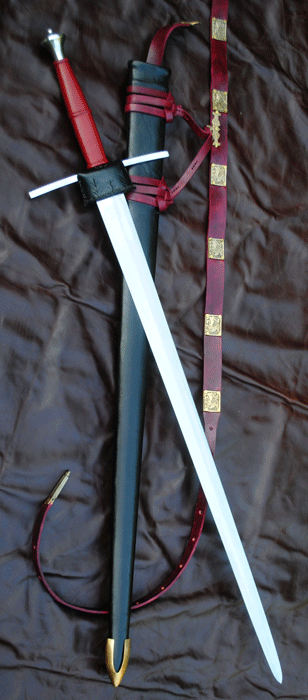
The whole package: I love how this one shows the resonance between the 'wolf's fang' chape and the XVIII's tip
 Attachment: 44.25 KB
Attachment: 44.25 KB

 Attachment: 82.44 KB
Attachment: 82.44 KB
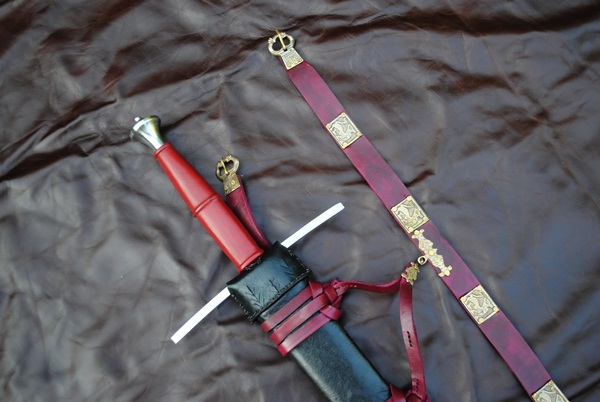
Throat, showing how the chappe seats on the riser, and flows into the scabbard body
 Attachment: 80.92 KB
Attachment: 80.92 KB
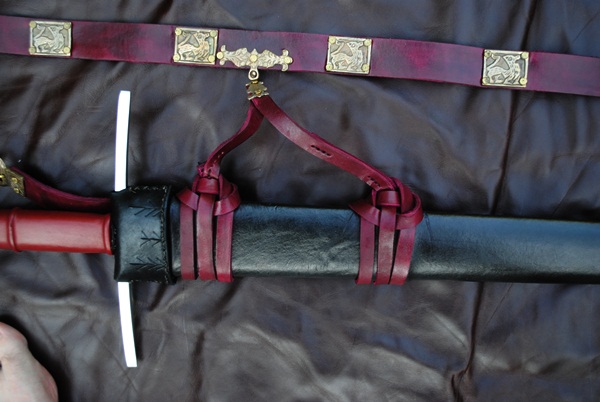
Suspension and wolf plaque detail
 Attachment: 92.25 KB
Attachment: 92.25 KB
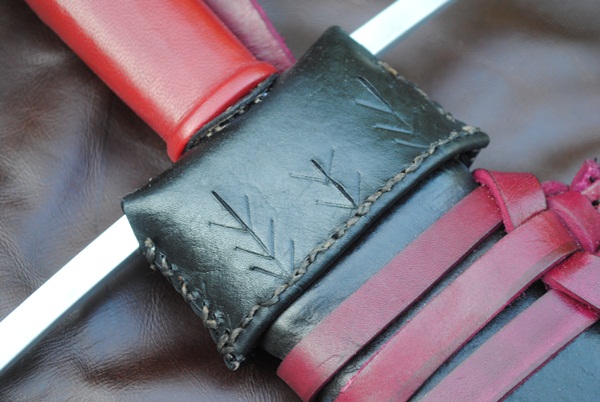
Chappe detail
 Attachment: 97 KB
Attachment: 97 KB
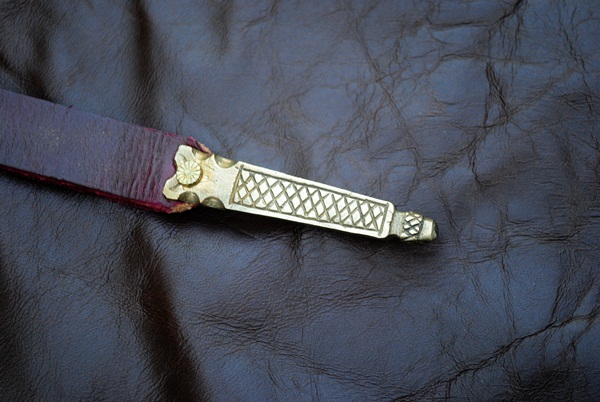
Strapend, showing acorn detail
 Attachment: 6.32 KB
Attachment: 6.32 KB

Buckle, showing detail of branches
 Attachment: 10.14 KB
Attachment: 10.14 KB
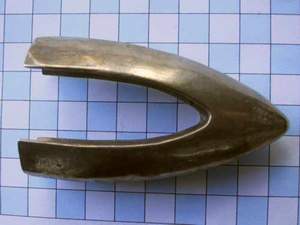
'Wolf's fang' chape
While also an ATrim, so not needing to be overly historically-accurate, the brief this time was for something a little more 'fancy', and close to historically accurate, to give me an idea of what this kind of commissioning process would be like. So this one was done under Russ' 'Trident line', with me able to choose the exact fittings to use, and with Russ devoting a lot of time and enthusiasm to fleshing out the concept. Again, this was something of a 'test run' to see what it would be like working with Russ. (Note that in each of these 'tests', neither Brian or Russ knew this: I was just commissioning a scabbard like anyone else - but my intention on each was to see what the process and result would be like, and whether I would send them more work in the future. I'm happy to report that I have sent both of them more work, and will again in the future.)
The result, dubbed 'Der Schwarzwaldwolf', or 'wolf of the Black Forest', was to be something that would not be out of place for a southern-German soldier in the mid to late 1470s. The idea was to get a mix of simplicity, even austerity, in the scabbard itself, as suggested by period art of what is now Switzerland, south Germany, and Austria, but with thematic personalization on the belt.
This theme was to combine the elements of both the wolf and the Black Forest. The wolf is represented in the belt plaques, as well as the tooth or fang-like shape of the chape, as well as the sleek lines of the scabbard overall. While we're used to seeing plaques in abundance on earlier 'knightly' belts, they apparently were still used in later periods as well, as a decorative feature. The artistic style used on this plaque might be suggestive of an earlier time; I was happy to think of them as having been handed down in a family and re-used to maintain a link to one's ancestors (my earliest-known ancestor was a German mercenary soldier, and I like the idea of finding ways to maintain links to one's direct forebears through one's bearing of arms in this way). The pointedness of the wolf's tooth is both suggestive of the sword point that resides behind it, and the oxblood of the grip is suggestive of the effect of that sharpness if the sword is removed from its sheath.
The Black Forest is reflected in the acorn detail on the strapend (oaks being a dominant species in the Black Forest), and the stylised branches on the buckle. The 'branch'-like iconography was carried over to the 'rain guard' / chappe - but this time, oriented vertically, they're now suggestive of trees. So, we go from the acorn, to the branches, to the trees themselves, to give a sense of cohesion across the package. I'll give close-up photos of each of these elements below, so you can get an idea of how this all 'hangs together' stylistically, as well as get a sense of the kind of detail that's available with higher-end mounts.
The 'rain guard' / chappe was the first one that Russ had ever made, and it was an interesting learning curve for both of us! Russ charged a very reasonable (I kept telling him it was too cheap) amount for the chappe, as my sword would be something of a 'guinea pig', and he didn't want to make any promises as to the outcome. He also saw it as a great challenge and way to learn about how to make something new - as well as a way to find out if this is something he'd like to add to his offerings ... I think he now is - at least, he's agreed to make another one for me - so, if you're wanting a chappe, ask him nicely and see what happens!
Russ and I were both interested in the recent research and experimentation here on myArmoury: Roland Warzecha and Hammaborg's experimentation with chappes in a functional WMA context, and custom projects documented here by Sean Flynt, Mathieu Harlaut, and Max W. Since then, we've also had Al Muckart's beautiful example in this post, for those who missed it.
Russ also referred to Sheaths, scabbards and grip coverings: Use of leather for portable personal objects in 14th-16th century Turku (Archaeologia Medii Finlandiae), by Janne Harjula (Skas, 2010) - details in this thread - which was being reprinted as we worked on the design, but Russ had sourced an older (and expensive!) copy to use, as it's one of the few historical resources we have for documentation of chappes.
Russ added a riser just below where the chappe would end, so that it seats nice an firmly when the sword is sheathed. This was a bit of a chicken-and-egg scenario: we wouldn't know how far down the riser needed to be without working out proper proportions for the chappe, but the chappe would need to be built to fit exactly to the riser. The final result works beautifully: the chappe is the right length based on our current understandings of its use martially, and the riser both provides a good seat, as well as a visual connection between the chappe mouth and scabbard body. The whole fit is tight, and helps to keep the sword in place when the scabbard is held upside-down, or while running (I love testing these details! :) )
I requested that he use black for the chappe, to both provide continuity with the scabbard, but also differentiation and striking looks when the sword is drawn; I really like how the chappe almost disappears when the sword is sheathed, but really adds character and presence to the unsheathed sword. I'm beginning to understand now why the majority of swords that we see in artwork of this time and place use chappes: in addition to Roland's findings in a martial context, they just look darn good.
Anyway, sorry if that's too much detail. I wanted to not only give some of the ideas that went into this design, but also some background on the process of what it was like seeing it through to final realization. Again, as a 'test run' for other scabbard projects, I learnt a lot, and am looking forward to the next commissions.

The whole package: I love how this one shows the resonance between the 'wolf's fang' chape and the XVIII's tip


Throat, showing how the chappe seats on the riser, and flows into the scabbard body

Suspension and wolf plaque detail

Chappe detail

Strapend, showing acorn detail

Buckle, showing detail of branches

'Wolf's fang' chape
Hi Ed
I have shown this in other threads, but any excuse to show it again is always welcom. It is my recent custom from Christian Fletcher. A Boarderwatch based on a Brescia Spadona Moat Sale item. And being true to the intent of the thread, also, the scabbard with the Triquetra Of The Order of Selohaar that he did for me.
Mike Ahrens
 Attachment: 64.67 KB
Attachment: 64.67 KB
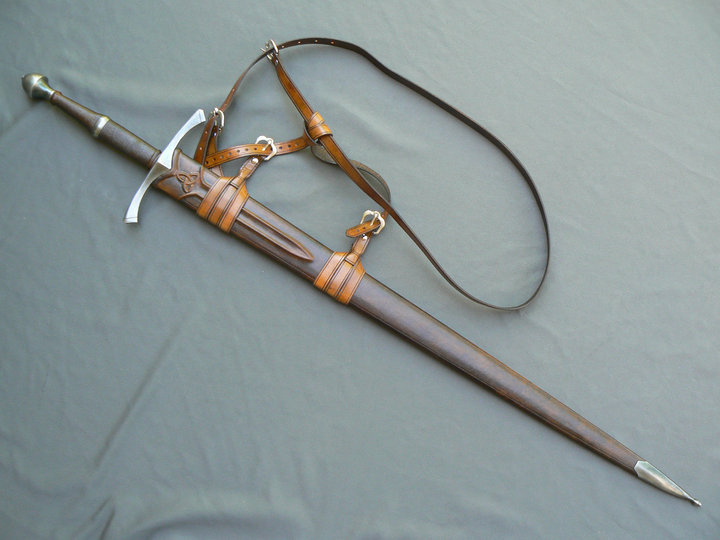
I have shown this in other threads, but any excuse to show it again is always welcom. It is my recent custom from Christian Fletcher. A Boarderwatch based on a Brescia Spadona Moat Sale item. And being true to the intent of the thread, also, the scabbard with the Triquetra Of The Order of Selohaar that he did for me.
Mike Ahrens

I'm catching up on the forum a little bit today, so I'm only now reading a bunch of these replies. :)
Anyway, I wanted to post pics of my other DBK scabbard that I just recently received. It's one of the "swordless" scabbards, that he was able to make without me shipping the sword to him. It fits perfectly, IMHO, so this worked out well. The scabbard is actually a darker gray than the pictures show. A medium gray scabbard with a black suspension, for the Albion Knight (with black grip):
[ Linked Image ]
[ Linked Image ]
[ Linked Image ]
[ Linked Image ]
Anyway, I wanted to post pics of my other DBK scabbard that I just recently received. It's one of the "swordless" scabbards, that he was able to make without me shipping the sword to him. It fits perfectly, IMHO, so this worked out well. The scabbard is actually a darker gray than the pictures show. A medium gray scabbard with a black suspension, for the Albion Knight (with black grip):
[ Linked Image ]
[ Linked Image ]
[ Linked Image ]
[ Linked Image ]
I would also like to comment that the above "Knight" scabbard was made by my wife Diane, under the "campaign" line. One of two apprentice scabbard makers of mine, and a fine one at that.
I do my own. It started with wood only scabbards and progressed to leather-wrapped wood scabbards.
[ Linked Image ]
[ Linked Image ]
[ Linked Image ]
Practice makes perfect...obviously I'm still in "Practice" mode.
Murphy :cool:
[ Linked Image ]
[ Linked Image ]
[ Linked Image ]
Practice makes perfect...obviously I'm still in "Practice" mode.
Murphy :cool:
Here's the second scabbard and 'rainguard'/chappe that Russ Ellis of Tritonworks made for me a little while back. This is on another ATrim (possibly a 1555?) ... again, getting a custom scabbard for a mid-range sword was a chance for me to experience the process of commissioning, before having scabbards made for higher-end pieces.
It was also a great chance for Russ to put into practice the lessons he learnt from his first 'rainguard'/chappe on the previous commission ... it's wonderful to see how much 'tighter' the stitching and overall lines are on this one. I'm happy to report that my 'cunning plan' has worked, and Russ now officially offers chappes as part of his services! (See http://www.tritonworks.com/trident)
In my quest to have chappes be a standard offering, I'm now commissioning two scabbards for Albions from Brian at DBK; once again, I'm happy for these to be 'guinea pigs' so that Brian will then be able to offer them to others ... will post the results here soon!
On this job, once again I went for a different colour on the chappe from the grip - this looks very striking in person. This one is a 'brother' sword to the previous 'Schwartzwaldwolf' - this time, the wolf fang (complete with drop of blood) is evoked by the chape, with the chappe being tooled with oak leaves.
Suspension is again with a removable hook-and-eyelet system, although this time in two points, rather than one. This adjustable system makes for great flexibility and comfort.
Russ had a lot of fun with this, and the result is fantastic!
 Attachment: 158.87 KB
Attachment: 158.87 KB

 Attachment: 80.5 KB
Attachment: 80.5 KB
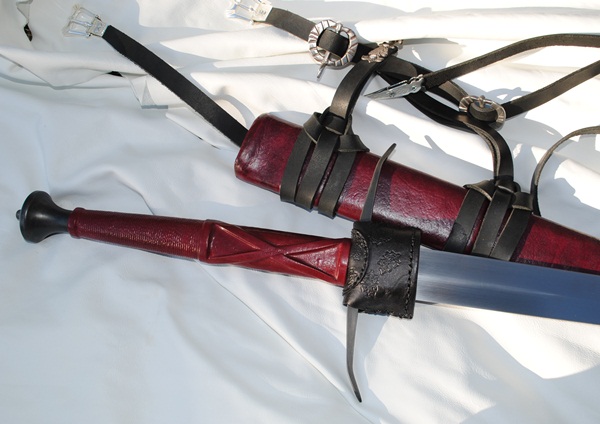
 Attachment: 143.51 KB
Attachment: 143.51 KB

 Attachment: 73.98 KB
Attachment: 73.98 KB
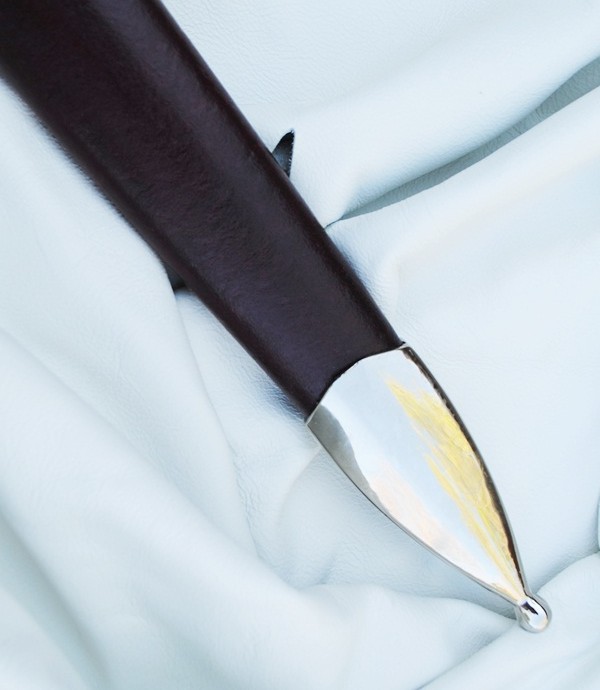
It was also a great chance for Russ to put into practice the lessons he learnt from his first 'rainguard'/chappe on the previous commission ... it's wonderful to see how much 'tighter' the stitching and overall lines are on this one. I'm happy to report that my 'cunning plan' has worked, and Russ now officially offers chappes as part of his services! (See http://www.tritonworks.com/trident)
In my quest to have chappes be a standard offering, I'm now commissioning two scabbards for Albions from Brian at DBK; once again, I'm happy for these to be 'guinea pigs' so that Brian will then be able to offer them to others ... will post the results here soon!
On this job, once again I went for a different colour on the chappe from the grip - this looks very striking in person. This one is a 'brother' sword to the previous 'Schwartzwaldwolf' - this time, the wolf fang (complete with drop of blood) is evoked by the chape, with the chappe being tooled with oak leaves.
Suspension is again with a removable hook-and-eyelet system, although this time in two points, rather than one. This adjustable system makes for great flexibility and comfort.
Russ had a lot of fun with this, and the result is fantastic!




Hello there, here is a scabbard for my sword made by Robert Moc from Slovakia. Both the sword and the scabbard were made by Robert.
 Attachment: 220.09 KB
Attachment: 220.09 KB
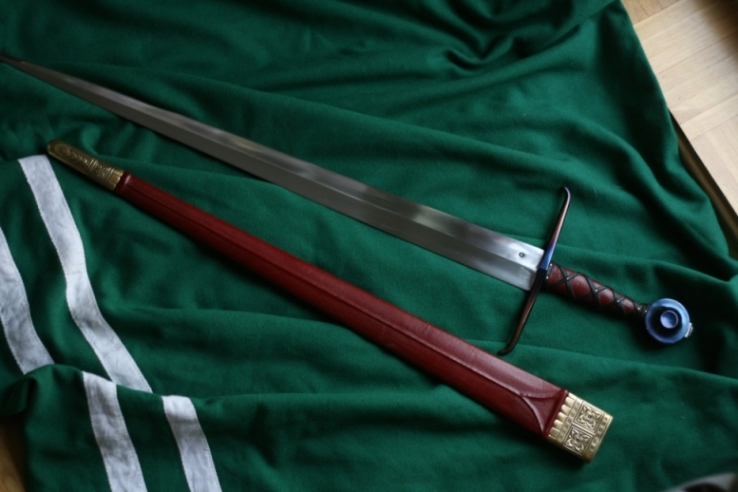
 Attachment: 206.76 KB
Attachment: 206.76 KB
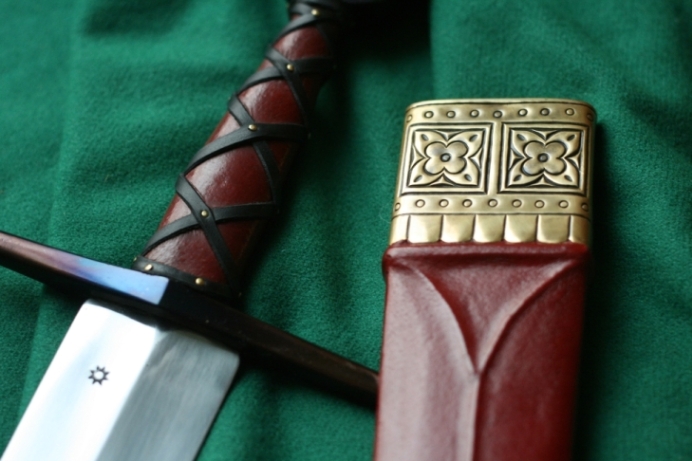
 Attachment: 192.86 KB
Attachment: 192.86 KB
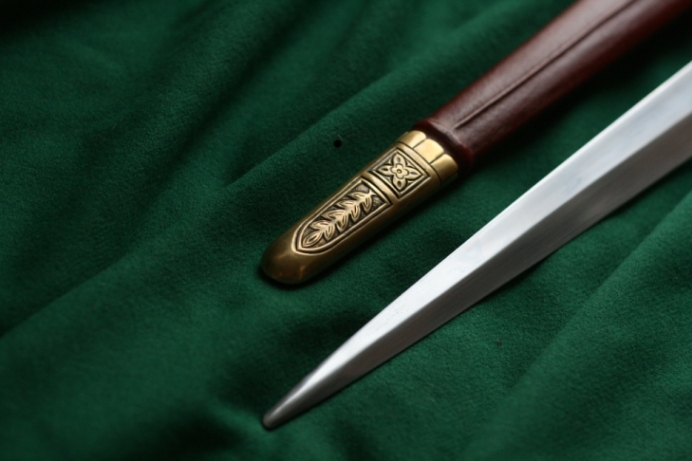



Here are some I've made, some of which are still in-progress The second from the left is the rough shape and I'm planing it this week. It's a DSA blade (blunt for the kiddies) made for the museum where I work. The second from the right is a scabbard nearing the end of construction. All have lanolin-oiled wool interiors. I put a layer of waxed linen under the leather. One of these days I'll try some metal fittings. Thanks to you all for your great postings!
 Attachment: 105.49 KB
Attachment: 105.49 KB
[ Download ]
[ Download ]
Page 1 of 1
You cannot post new topics in this forumYou cannot reply to topics in this forum
You cannot edit your posts in this forum
You cannot delete your posts in this forum
You cannot vote in polls in this forum
You cannot attach files in this forum
You can download files in this forum
All contents © Copyright 2003-2006 myArmoury.com — All rights reserved
Discussion forums powered by phpBB © The phpBB Group
Switch to the Full-featured Version of the forum
Discussion forums powered by phpBB © The phpBB Group
Switch to the Full-featured Version of the forum